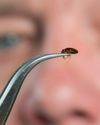
Hurricanes are some of the most powerful storms on Earth, drawing their energy from warm tropical waters in the Atlantic or north-eastern Pacific. In other parts of the world, these swirling storms are known as typhoons (in the north-western Pacific) or cyclones (South Pacific and Indian Ocean). These storms form above ocean waters when warm, moist air rises. This draws in more humid air from surrounding areas, and as the air rushes in, the Coriolis effect (created by the Earth’s spin) causes it to follow a curved path, leading the developing storm to spin anticlockwise in the northern hemisphere. As the rising air cools, the moisture condenses out and forms rain clouds. As long as there’s sufficient heat from the oceans, the storm continues to grow, and it may eventually be intense enough to produce the 119km/h winds that officially define a hurricane. As the hurricane rotates faster, a calm ‘eye’ of low air pressure forms at its centre, surrounded by the strongest winds. The Saffir-Simpson hurricane wind scale classifies hurricanes from 1 to 5 based on wind speed, with category 5 hurricanes fostering winds of 250km/h and above.
Most hurricanes in the North Atlantic form off the western coast of Africa, and are carried to North America, the Caribbean and the Gulf of Mexico by the prevailing easterly winds. Once they make landfall, they weaken and dissipate, but not before unleashing devastatingly strong winds and heavy rains on anything in their path, as well as causing storm surges (an abnormal rise in sea level). An average of six hurricanes are produced in the Atlantic every year, but the 2020 season was exceptionally active.
Bu hikaye Very Interesting dergisinin May/June 2021 sayısından alınmıştır.
Start your 7-day Magzter GOLD free trial to access thousands of curated premium stories, and 9,000+ magazines and newspapers.
Already a subscriber ? Giriş Yap
Bu hikaye Very Interesting dergisinin May/June 2021 sayısından alınmıştır.
Start your 7-day Magzter GOLD free trial to access thousands of curated premium stories, and 9,000+ magazines and newspapers.
Already a subscriber? Giriş Yap

TAKE IT SLOW
Slow running is a fitness trend with some hard and fast science behind it

Physics, AI and music share a common thread. You just have to know where to look
Studying science can lead you in many directions and open doors to unexpected possibilities along the way

BED BUGS VS THE WORLD
When bloodthirsty bed bugs made headlines for infesting Paris Fashion Week in 2023, it shone a spotlight on a problem that's been making experts itch for decades: the arms race going on between bed bugs and humans

Kids are the key to understanding obesity. But we need more of their genes...
We can unravel the role that bodyweight plays in disease, but we need a bigger, more diverse, sample of genetic material to do so

COVID inquiry: What did we learn and what can we do better in future pandemics?
Masks, social distancing, lockdowns... how effective was the UK's response to the COVID-19 pandemic?

One hormone could be the key that unlocks a cure for morning sickness
The nausea and vomiting that, in extreme cases, can endanger mothers and babies might soon be just a memory

THE WORLD'S WEIRDEST CREATURES
Under the sea and upon the land, some animals look - to us - pretty strange...

WHEN MIND AND MACHINE COLLIDE
First, Elon Musk wanted to make electric cars ubiquitous, then he wanted to make space exploration a private enterprise. Now, with Neuralink, his newest venture, Musk hopes to merge humans and artificial intelligence. Turns out, it might not be such a crazy idea...

COME OUT OF YOUR SHELL
Social anxiety is more than just being shy. It's a phobia born out of our evolutionary past. But that raises a puzzling question: why do so many of us fear human interaction when we're supposed to be the most sociable species on the planet?

SPACE ODDITIES
Take a tour of the weirdest spots in the universe, where the 'normal' rules don't apply. Places that squeeze time, blow bubbles and even rain glass... sideways